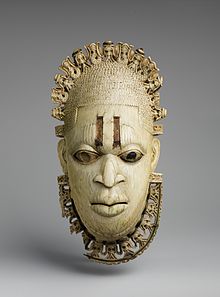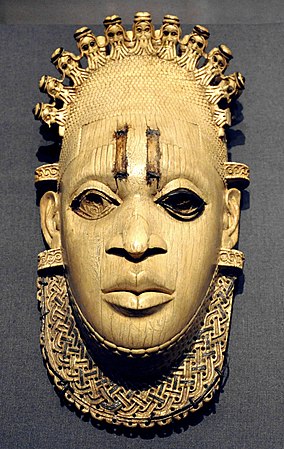Benin ivory mask
| Benin ivory mask | |
|---|---|
 One of four related ivory pendant masks, taken during the punitive expedition of 1897. | |
| Material | Ivory, iron inlay |
| Height | 24.5cm |
| Width | 12.5cm |
| Depth | 6cm |
| Created | Sixteenth century AD |
| Discovered | Benin City |
| Present location | Metropolitan Museum of Art, British Museum, Seattle Art Museum, Linden Museum, private collection |
| Registration | 1978.412.323, Af1910,0513.1, 81.17.493, F 50565 |
| Culture | Benin Court Art |
| Measurements are from the British Museum version; other versions have slightly different dimensions. | |
The Benin ivory mask is a miniature sculptural portrait in
Two almost identical masks are kept at the British Museum in London and at the Metropolitan Museum of Art in New York City.[1][2] Both feature a serene face of the Queen Mother wearing a beaded headdress, a beaded choker at her neck, scarification highlighted by iron inlay on the forehead, all framed by the flange of an openwork tiara and collar of symbolic beings, as well as double loops at each side for attachment of the pendant.
Until its restitution in 2022 to Nigeria, the Linden Museum in Germany[3] had such a mask in its collection. Further, there are also similar masks at the Seattle Art Museum[4] and one in a private collection.[5][6]
The British Museum example in particular has also become a cultural emblem of modern Nigeria since FESTAC 77, a major pan-African cultural festival held in Lagos, Nigeria in 1977, which chose as is official emblem a replica of the mask crafted by Erhabor Emokpae.[7]
Origins
Three of the ivory masks
-
Metropolitan Museum of Art, New York
-
British Museum, London
Benin Empire
In the early 16th century, the dynamic
Ritual use
The
Four rungs on the side of the masks, above and below each ear, let the masks hang in suspension
Description and interpretation
They are made of ivory, long and ovular in shape,
A powerful woman
The depiction of women is rare in

The foreheads of both masks were are inscribed with four vertical
Trade symbol

Ivory, both then and now, connotes royal wealth, power, and purity.[11] Ivory, already a luxury commodity in Africa, became increasingly coveted with the growth of the European ivory trade.[32] When an elephant was killed in Benin, the Oba received one tusk as a gift and was offered the other in sale. Thus, the Oba had many tusks and controlled the ivory trade.[33] Ivory is associated with the Edo orisha of the sea, Olokun. As this orisha gives wealth and fertility, it the spirit world's equivalent of the Benin Oba. Ivory gave wealth similar to Olokun, as it enticed the Portuguese merchants who, in turn, returned wealth to Benin.[33] The Portuguese belonged to Olokun, having arrived from the sea.[18] The whiteness of ivory also reflects the symbolism of white chalk, whose ritual purity is associated with Olokun.[33][34][35]
The
Provenance
During the 1897
Five to six masks of this type[38] were found in a large chest in 1897 in the bedchamber of the then-reigning Oba Ovonramwen, the ruler at the Benin court. They were taken at a time of great civil unrest during the British punitive Benin Expedition of 1897, the British burned the royal palaces of the Oba and the Queen Mother and looted thousands of ivory, brass and wood artworks from the ancestral altars, private quarters and storerooms and many were sold in England to western museums and collectors to offset the cost of the expedition.[39][6] The British Museum's pendant was purchased in 1910 from the British anthropologist Prof Charles Gabriel Seligman.[13]
The Met's mask was acquired in 1972 as a gift of
Legacy
The Benin Pendant Mask has become an
The Met's Queen Mother pendant mask is considered among the museum's most celebrated works.[42] African art historian Ezio Bassani wrote that the profile of the Met's mask was "at once delicate and strong" with a "musical rhythm", and that its use of iron and copper inlay was both "discreet and functional".[15] He wrote that the Metropolitan and British Museum masks were among the most beautiful ivories carved in Benin, and that their artist was both refined and sensitive.[15] Kate Ezra wrote that the mask's thinness showcased the "sensitivity and solemnity" of early Benin art.[11]
See also
- Bronze Head from Ife
- Bronze Head of Queen Idia
- Okukor, a bronze at Jesus College, Cambridge
- Benin Altar Tusk
Notes
- ^ "Ivory mask - Google Arts & Culture". Google Cultural Institute. Retrieved 2017-02-24.
- ^ a b c d Metropolitan Museum Collection Queen Mother Pendant Mask: Iyoba, MetMuseum, retrieved 1 November 2014
- ^ Lindenmuseum. "Linden-Museum - Afrika". www.lindenmuseum.de (in German). Archived from the original on 2017-02-23. Retrieved 2017-02-22.
- ^ "Collections - SAM - Seattle Art Museum". www1.seattleartmuseum.org. Archived from the original on 2017-11-09. Retrieved 2017-02-22.
- ^ "Sotheby's to auction 'Oba' mask". Financial Times. Retrieved 2017-02-22.
- ^ a b c "Sotheby's cancels sale of 'looted' Benin mask". The Independent. 2010-12-29. Retrieved 2017-02-22.
- ^ ISBN 978-0-8108-6316-3.
- ^ a b c d e f g h i j k l m n o LaGamma 2011, p. 28.
- ^ a b LaGamma 2011, p. 29.
- ^ LaGamma 2011, p. 26.
- ^ a b c d e Ezra 1984, p. 21.
- ISBN 9780870996337.
- ^ a b British Museum Collection, British Museum, retrieved 1 November 2014
- ^ ISBN 9781305888418.
- ^ a b c d e f g h i j k l Bassani 1991, p. 183.
- ^ a b Bassani 1991, p. 182.
- ^ Goldwater, Robert (1969-06-01). Art of Oceania, Africa, and the Americas from the Museum of Primitive Art. Metropolitan Museum of Art.
- ^ a b c Ezra 1984, p. 18.
- ^ a b Ezra 1984, pp. 20–21.
- ISBN 0870994611. Retrieved 1 November 2014.
- ISBN 9780870996337.
- ^ a b LaGamma 2011, pp. 26–28.
- ^ The Met's mask uses iron inlay in the pupils and forehead markings, and copper inlay for the eyelid outline.[15]
- ^ Ben-Amos 1980.
- ^ Bortolot, Alexander Ives. "Idia: The First Queen Mother of Benin | Essay | Heilbrunn Timeline of Art History | The Metropolitan Museum of Art". The Met's Heilbrunn Timeline of Art History. Retrieved 2017-02-24.
- ^ ISBN 9780195148909.
- ISBN 9780870996337.
- ISBN 9780714125916.
- ISBN 9780470692820.
- ^ a b Luschan, Felix von; Ankermann, B; Arthur Baessler-Stiftung (1919-01-01). Die Altertümer von Benin (in German). Berlin; Leipzig: De Gruyter. Archived from the original on 2017-03-07. Retrieved 2017-03-01.
- ISBN 9783791325804.
- ^ Ezra 1984, p. 14.
- ^ a b c Ezra 1984, p. 16.
- ISBN 0870994611. Retrieved 1 November 2014.)
{{cite book}}: CS1 maint: multiple names: authors list (link - ISBN 9781506317861.
- ISBN 9781588391902.
- ^ Cunard, Nancy (1934-01-01). Negro. Anthology made by N. Cunard, 1931-1933. [With illustrations. London: Nancy Cunard. Archived from the original on 2017-03-07. Retrieved 2017-03-01.
- ISBN 9780714115443.
- ISBN 9780415273190.
- ^ LaGamma 2014, pp. 4–6.
- ^ LaGamma 2014, pp. 5–7.
- ^ a b LaGamma 2014, p. 7.
- ^ The wealth of Africa, British Museum, retrieved 1 November 2014
- ISBN 9781317281832.
- ISBN 9781118515051.
- ^ "FESTAC at 40: The history and mystery behind the mask". Vanguard News. 2017-02-27. Retrieved 2017-02-28.
- ISBN 9780226023564.
- ISBN 9780905450827.
- ISSN 0190-8286. Retrieved 2017-02-28.
- ^ Matsuura, Koïchiro (2005-05-25). "On the occasion of the unveiling of Queen Idia's Mask" (PDF). UNESCO.
References
- Bassani, Ezio (1991). "#66: Mask". In Levenson, Jay A.; OCLC 797827885.
- Ben-Amos, Paula (1980). The Art of Benin. London: Thames & Hudson. p. 81.
- Ezra, Kate (1984). African Ivories. New York: OCLC 893698097.
- LaGamma, Alisa (2011). "Idia of the Ivory Pendant Masks". Heroic Africans: Legendary Leaders, Iconic Sculptures. New York: OCLC 781712515.
- LaGamma, Alisa (Summer 2014). "The Nelson A. Rockefeller Vision: In Pursuit of the Best in the Arts of Africa, Oceania, and the Americas". The Bulletin of the Metropolitan Museum of Art. 72 (1): 4–17. OCLC 01624350.





